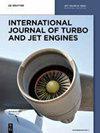Heat transfer distribution of single oblique jet impingement in crossflow under different inlet conditions
IF 0.9
4区 工程技术
Q4 ENGINEERING, AEROSPACE
引用次数: 0
Abstract
Abstract To further reveal the interaction between crossflow and jet, single oblique jet impingement in crossflow is studied. The influences of Reynolds number (Re = 3750–15,000), oblique angle (θ = 50°–90°), jet intake mode (jet normal to inlet plane and jet along hole axis), crossflow ratio (CR = 0.1–0.3) and temperature ratio (TR = 1.0–1.2) are considered. For both jet intake modes, with the decrease of θ, the peak value of Nusselt number increases and its location shifts upstream. The Nusselt number for case of jet normal to inlet plane is higher than that of jet along hole axis with wider lateral coverage range. The CR affects the convection heat transfer between crossflow and target surface, and it also affects the interaction between crossflow and jet. Synthetically, the best heat transfer appears at CR = 0.2. The Nusselt number decreases sharply when TR goes from 1.0 to 1.1, while the decline trend slows down when TR goes from 1.1 to 1.2.不同进口条件下单斜射流在横流中的换热分布
为了进一步揭示横流与射流的相互作用,研究了横流中单斜射流的撞击。考虑了雷诺数(Re = 3750 ~ 15000)、斜角(θ = 50°~ 90°)、进气方式(喷流垂直于进口平面和喷流沿孔轴方向)、横流比(CR = 0.1 ~ 0.3)和温度比(TR = 1.0 ~ 1.2)的影响。对于两种进气模式,随着θ的减小,努塞尔数的峰值增大,其位置上移。射流垂直于进口平面时的努塞尔数高于沿孔轴方向的努塞尔数,且射流横向覆盖范围较宽。对流换热影响着横流与靶面的对流换热,也影响着横流与射流的相互作用。综合来看,CR = 0.2时传热效果最佳。当TR从1.0到1.1时,Nusselt数急剧下降,而当TR从1.1到1.2时,下降趋势放缓。
本文章由计算机程序翻译,如有差异,请以英文原文为准。
求助全文
约1分钟内获得全文
求助全文
来源期刊

International Journal of Turbo & Jet-Engines
工程技术-工程:宇航
CiteScore
1.90
自引率
11.10%
发文量
36
审稿时长
6 months
期刊介绍:
The Main aim and scope of this Journal is to help improve each separate components R&D and superimpose separated results to get integrated systems by striving to reach the overall advanced design and benefits by integrating: (a) Physics, Aero, and Stealth Thermodynamics in simulations by flying unmanned or manned prototypes supported by integrated Computer Simulations based on: (b) Component R&D of: (i) Turbo and Jet-Engines, (ii) Airframe, (iii) Helmet-Aiming-Systems and Ammunition based on: (c) Anticipated New Programs Missions based on (d) IMPROVED RELIABILITY, DURABILITY, ECONOMICS, TACTICS, STRATEGIES and EDUCATION in both the civil and military domains of Turbo and Jet Engines.
The International Journal of Turbo & Jet Engines is devoted to cutting edge research in theory and design of propagation of jet aircraft. It serves as an international publication organ for new ideas, insights and results from industry and academic research on thermodynamics, combustion, behavior of related materials at high temperatures, turbine and engine design, thrust vectoring and flight control as well as energy and environmental issues.
 求助内容:
求助内容: 应助结果提醒方式:
应助结果提醒方式:


